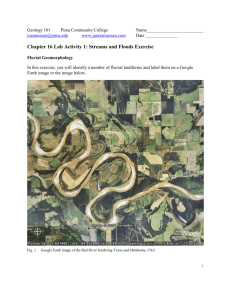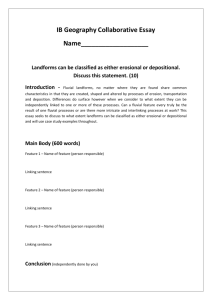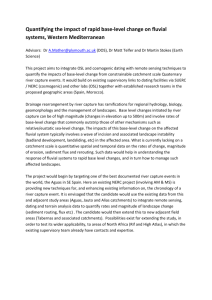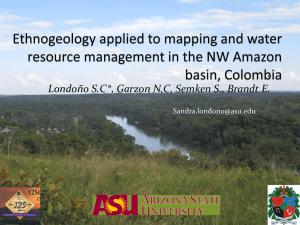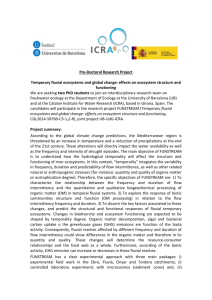October 1999 Rocky Mountain Research Station
advertisement
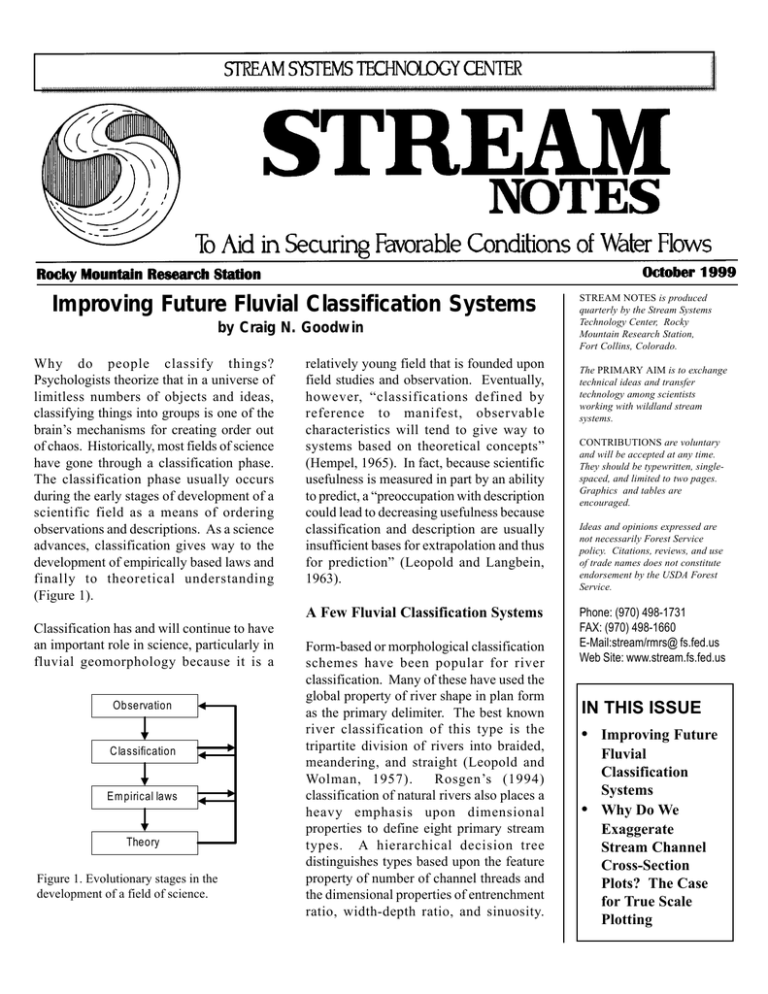
October 1999 Rocky Mountain Research Station Station Improving Future Fluvial Classification Systems by Craig N. Goodwin Why do people classify things? Psychologists theorize that in a universe of limitless numbers of objects and ideas, classifying things into groups is one of the brain’s mechanisms for creating order out of chaos. Historically, most fields of science have gone through a classification phase. The classification phase usually occurs during the early stages of development of a scientific field as a means of ordering observations and descriptions. As a science advances, classification gives way to the development of empirically based laws and finally to theoretical understanding (Figure 1). relatively young field that is founded upon field studies and observation. Eventually, however, “classifications defined by reference to manifest, observable characteristics will tend to give way to systems based on theoretical concepts” (Hempel, 1965). In fact, because scientific usefulness is measured in part by an ability to predict, a “preoccupation with description could lead to decreasing usefulness because classification and description are usually insufficient bases for extrapolation and thus for prediction” (Leopold and Langbein, 1963). A Few Fluvial Classification Systems Classification has and will continue to have an important role in science, particularly in fluvial geomorphology because it is a Observation C lassification Empirical laws Theory Figure 1. Evolutionary stages in the development of a field of science. Form-based or morphological classification schemes have been popular for river classification. Many of these have used the global property of river shape in plan form as the primary delimiter. The best known river classification of this type is the tripartite division of rivers into braided, meandering, and straight (Leopold and Wolman, 1957). Rosgen’s (1994) classification of natural rivers also places a heavy emphasis upon dimensional properties to define eight primary stream types. A hierarchical decision tree distinguishes types based upon the feature property of number of channel threads and the dimensional properties of entrenchment ratio, width-depth ratio, and sinuosity. STREAM NOTES is produced quarterly by the Stream Systems Technology Center, Rocky Mountain Research Station, Fort Collins, Colorado. The PRIMARY AIM is to exchange technical ideas and transfer technology among scientists working with wildland stream systems. CONTRIBUTIONS are voluntary and will be accepted at any time. They should be typewritten, singlespaced, and limited to two pages. Graphics and tables are encouraged. Ideas and opinions expressed are not necessarily Forest Service policy. Citations, reviews, and use of trade names does not constitute endorsement by the USDA Forest Service. Phone: (970) 498-1731 FAX: (970) 498-1660 E-Mail:stream/rmrs@ fs.fed.us Web Site: www.stream.fs.fed.us IN THIS ISSUE • Improving Future Fluvial Classification Systems • Why Do We Exaggerate Stream Channel Cross-Section Plots? The Case for True Scale Plotting Entrenchment ratio, sinuosity, and width-depth ratio have fuzzy decision rules that acknowledge the continuum of stream variability. Sediment size and channel slope are used to classify these types into subcategories. An example of a process-based classification system is that proposed by Whiting and Bradley (1993) which utilizes dimensional measures of fluvial form in their classification system for headwater streams. Forty-two stream classes are defined on the basis of domains in three twodimensional phase space “panels” where the domains represent different and distinct physical processes and their relative rates. The domains are process interpretations based upon dimensional properties of morphological features, which include channel gradient, channel width, valley width, and median sediment size. 2. Base Classifications upon Processes or Controlling Factors Many fluvial classification schemes have been based wholly or in part upon characteristics of channel form. Channel forms, although readily measurable, are the end products of complex, dynamic systems (Figure 2). These end products may be non-unique manifestations of underlying controlling factors and processes. The lack of a one-to-one correspondence between geomorphic process and form suggests that measurement of fluvial processes or controlling factors, albeit difficult, may be a better pathway to discovering natural kinds of rivers. Controlling Inputs W a te r d is c h a rg e S e d im e n t d is c h a rg e Constra ints Montgomery and Buffington’s (1997) classification system defines seven channel types based upon overall qualitative morphological character. Seven fuzzy, mainly feature characteristics are used to define whether or not a stream is of a given type. Montgomery and Buffington’s use of adjective feature descriptors of typical and dominant illustrate that these are desirable features but not absolutely necessary for describing a type. The system uses illustration to communicate the abstract conceptualizations of their types Improving Fluvial Classification Systems Within this section I offer ten recommendations to improve future fluvial classification systems. 1. Base Classifications on Natural Kinds Assuming there are natural kinds (Collier, 1996) of rivers, these kinds (natural groupings as opposed to human abstractions) should be intimately linked with natural laws of river development. Thus, classification systems based on natural kinds should have utility in explaining and predicting river conditions. The goal for the classifier is to determine what those natural kinds are. Va lle y s lo p e & w id th B o u n d a ry co n d itio n s Fluvial Erosion S e dim e nt Tra nsport De position Fluvial Cha nne l type Re a ch fe a ture s Figure 2. Simple conceptualization of relationship among controlling variables, fluvial processes, and fluvial forms. Most classification systems have concentrated on fluvial forms, which are the output products of a complex, dynamic system. 3. Base Classifications upon Temporal Change and Thresholds Extend the process-based idea presented in recommendation 2 to longer temporal spans wherein rivers are truly perceived not as “things in space” but as “processes through time.” These types of classification systems might include concepts of equilibrium and disequilibrium showing departures from a steady state and could include measures such as the ratio of reaction time to relaxation time or threshold parameters. 4. Base Classifications on Theory Many fields of science begin with an observationbased classification stage and then advance to law-forming and theory development stages. After some period of growth in a scientific field, all of these stages occur simultaneously, with feedbacks from more advanced levels of knowledge guiding less advanced levels (Figure 1). Thus, at some evolutionary point, even observations are based upon theory and not just upon mindless collection of data. With time, classification should become less dependent upon purely observational input and more dependent upon geomorphological theory. 5. Base Classifications on a Probabilistic View Most classification systems in geomorphology and other scientific fields have been based upon the classical view in which members are placed into categories based upon “necessary and sufficient” conditions. A more recently developed probabilistic theory does not require all properties to be true of all class members. Class members vary in the degree both to which they share a property and to which they represent a class. Probabilistic classification concepts appear to hold much promise, particularly since necessary and sufficient conditions of the classical view are replaced by central tendency conditions, which provide more flexibility for the complex continuum of the fluvial system. Although none of the existing fluvial classification systems implement a probabilistic view, Montgomery and Buffington’s (1997) system is a step in that direction. 6. Calibrate and Verify Classifications for Prediction Recommendations 1, 2, 3, and 4 intertwine classification with scientific understanding and explanation of fluvial conditions. If the goal of using a classification system is to make management predictions (as opposed to increasing understanding), then a purely empirical rather than rationale approach to classification can be taken. If empirical predictive classification schemes are to be developed and used, then they should be calibrated, verified, and updated as more outcome data become available. 7. Incorporate Size Factors into Classification Systems Nearly all existing fluvial classification schemes ignore size and scale aspects in their derivation. Although size measurements may be made to derive classification parameters, these measurements are usually converted into dimensionless shape or pattern indicators (e.g., width-depth ratio and sinuosity). Scale issues, however, are significant both in absolute and in relative ways, and classification systems that effectively incorporate size factors may prove beneficial in endeavors such as stream restoration. 8. Use Nomenclature that Improves Communication The fluvial environment is being examined by professionals from many disciplines. For individuals from diverse interests to effectively describe and communicate the aspects of a complex natural system, a classification system that “creates order out of chaos” is beneficial. Classifications devised to aid communication need not be based upon natural kinds, for the purpose is merely to allow individuals to develop mental pictures of rivers. For this reason, form-based classification systems are most useful, for forms are more intuitive and understandable to humans than are geomorphic processes. A key aspect of a classification scheme of this type should be its composition of a readily understandable nomenclature. The following nomenclature rules, adapted from Hill (1963), are suggested: · · · · · A name should be widely understood and used. A name should be descriptive or explanatory. A name should be a common word, if possible. A name should be rational and appropriate to the science involved. Symbolic and/or mnemonic terms may be used if they are more practical than descriptive terms. · The same thing should not be given two different names nor different things given the same name. · A name should represent a group of things, processes, or concepts, and if possible, should also be part of a greater group. classification systems. However, classification should be considered only one part of a much larger scientific puzzle that also incorporates observation, laws, hypotheses, theories, and models. References 9. Treat Classifications as Hypotheses — Not as Paradigms In some respects, classification schemes can be treated similarly to hypotheses in that their development is undertaken to seek to explain regularities in nature. If classification systems are viewed as hypotheses with respect to their use, then each additional use becomes a test either verifying or nullifying their explanatory capability. As evidence amasses regarding a classification scheme’s explanatory or predictive capability, modifications can be made, and, if necessary, it can be discarded in favor of a new system. Unfortunately, theories, and perhaps classification schemes, can become paradigms that are the only way a field of science evaluates a particular class of problems. Classification paradigms should be avoided for a science to continue advancing. 10. Ignore Classification Much of the desire to classify rivers may derive from fluvial geomorphology’s composite heritage from geology and geography — fields where observation, description, and classification have played major roles. In other disciplines, classification plays little or no part. As geomorphological theory advances, conceptual and mathematical geomorphological models will undoubtedly provide capabilities not inherent in classification systems. Conclusion Classification has and will continue to have an important role in science, particularly for fluvial geomorphology, which is solidly founded upon field studies and observation. A fuller understanding of the principles behind classification system development should improve the design of future Collier, J., 1996. On the Necessity of Natural Kinds. In: Riggs, P. J. (ed.), Natural Kinds, Laws of Nature and Scientific Methodology. Kluwer Academic Publishers, Dordrecht, pp. 1-10. Hempel, C. G., 1965. Aspects of Scientific Explanation. The Free Press, New York, 505 pp. Hill, M. L., 1963. Role of Classification in Geology. In: Albritton, C. C. (ed.), The Fabric of Geology. Addison-Wesley, Reading, Mass., pp. 164-174. Leopold, L. B. and W. B. Langbein, 1963. Association and Indeterminacy in Geomorphology. In: Albritton, C. C. (ed.), The Fabric of Geology. Addison-Wesley, Reading, Mass., pp. 184-192. Leopold, L. B. and M. G. Wolman, 1957. River Channel Patterns: Braided, Meandering and Straight. U.S. Geological Survey Professional Paper 282-B, pp. 39­ 85. Montgomery, D. R. and J. M. Buffington, 1997. ChannelReach Morphology in Mountain Drainage Basins. Geological Society of America Bulletin 109:596-611. Rosgen, D. L., 1994. A Classification of Natural Rivers. Catena 22:169-199. Whiting, P. J. and J. B. Bradley, 1993. A Process-Based Classification System for Headwater Streams. Earth Surface Processes and Landforms 18:603-612. Craig Goodwin is a geomorphologist and a Doctoral Student/Research Associate, Watershed Science Unit/Rangeland Resources, Utah State University, Logan, Utah 84322­ 5230; (435) 797-1587; goodwin@cc.usu.edu. The complete article, Goodwin, Craig N., 1999. Fluvial Classification: Neanderthal Necessity or Needless Normalcy. In: D.S. Olson and J.P. Potyondy (editors), Wildland Hydrology, American Water Resources Association, TPS­ 99-3, Herndon, Virginia, pp. 229-236, may be dowloaded from the STREAM Web site (www.stream.fs.fed.us) FTP download area. Why Do We Exaggerate Stream Channel Cross-Section Plots? The Case for True Scale Plotting by John Potyondy and Larry Schmidt Perception often governs reality. The way people perceive objects has a profound influence on the way they conceptualize the objects. This is true for tangible objects that we identify with our senses, but it applies equally well to concepts and ideas. This article illustrates how typical displays of stream channel cross-section data confuse perception and lead to misinterpretation of stream channels and how they operate. Most people recognize the characteristics of a square. It is a familiar basic geometric shape learned at an early age. But suppose for a moment that you must illustrate a square for a person unfamiliar with the concept. Your basic description might say, for example, that a square is a rectangle with four equal sides (Figure 1). Now consider the effect on the person’s perception of a square if you provided an illustration of the square with a 2 to 1 vertical exaggeration (Figure 2). Even though the exaggeration is clearly identified, it is likely that the person will carry a warped view of what a square is. A rational person would reject the notion that this is a good way to illustrate a square and would consider it a poor way to teach a person the concept of a square. As absurd as this example seems, this is the typical case when plotting and displaying stream channel cross-sections. Consider the following example of a cross-section plot of the South Fork Cache la Poudre River in Colorado. The South Fork Cache la Poudre is a typical mountain gravel-bed river, about 40 feet wide and 3 feet deep at bankfull stage. The river flows through a broad alluvial valley meadow and can be characterized as a Rosgen C-3 stream type. The plot in Figure 3 illustrates how the crosssection is typically displayed when plotted with a standard computer spreadsheet, such as Excel. One problem with this display is that it does not show the cross-section as it appears in the natural world. This is because vertical elevation and horizontal distance are not plotted at identical scales. For the cross-section to appear as it does in reality, it would have to be plotted at a 1:1 vertical-to-horizontal ratio. In this example, the computer graphing software exaggerated the vertical scale by a factor of 5 giving it a 5:1 vertical-to-horizontal ratio. In other words, each foot on the vertical scale is 5 times that of the distance used to show 1 foot on the horizontal scale. In contrast, Figure 4 shows a true representation of the actual stream cross-section (plotted at a 1:1 ratio); one that is close to how we actually see and perceive the stream were we to stand on its banks. Figure 1. A square. Figure 2. A square with 2:1 vertical exaggeration. While the astute viewer may be aware of the exaggerated nature of the plot in Figure 3, the casual viewer will probably draw different conclusions about river behavior from the exaggerated versus the real-life scale plot. Figure 3. Plot of the South Fork Cache la Poudre River cross-section as the data is directly plotted by a typical spreadsheet plotting program. The vertical axis is exaggerated by a factor of 5 making for a 5:1 vertical-to-horizontal plotting ratio. The exaggerated nature of the plot conveys a distorted view of the river’s true cross-sectional characteristics. Figure 4. Plot of South Fork Cache la Poudre River cross-section at a 1:1 ratio without vertical exaggeration. Figure 5. Panoramic view of the South Fork of the Cache la Poudre River cross-section. In the exaggerated plot (Figure 3), the South Fork Cache la Poudre River appears to be a relatively deep river. Depth appears to change dramatically over short distances across the channel and one might be tempted to conceptually think of this river as one which is fast and deep. Because of the large vertical distances between low base flows and flows which fill the channel, it looks like the river fluctuates a great deal between wet and dry seasons. The elevation of bankfull stage is identified, but the flat depositional bankfull feature appears to be poorly defined and the associated floodplain appears to be very narrow. Based on this depiction, it might be difficult to convince someone that the active floodplain associated with bankfull discharge is easy to identify. It also looks like a lot of additional water will be needed before the flow leaves the channel and inundates adjacent lands. In contrast, the 1:1 cross-section plot (Figure 4) conveys an alternative view of the river channel. From the true-scale plot, the South Fork Cache la Poudre River appears to be fairly wide and shallow, rather than deep and narrow. The river appears to be easily wadeable with gradual changes in depth. The depositional flat of the floodplain associated with bankfull stage is much more distinct and spans a wide band along the edge of the river. Small increases in stage above bankfull will quickly inundate adjacent riparian ecosystems. In essence, this plot shows the dimensions of the river as one would perceive it standing along its banks. It is almost always wise to view cross-sections at a 1:1 ratio to gain an appreciation for how they actually look spatially. Most spreadsheet graphics allow users to compress the vertical scale of the plot and to manually resize the vertical scale. Some software programs, such as WinXSPRO, allow users to change the plotting ratio so that the cross-section can be viewed at 1:1 and other scales of vertical exaggeration. When rivers are wide, it may not be possible to show cross-sections at a 1:1 ratio. In these cases, consider using the lowest ratio feasible and note on the figure or in the caption the amount of vertical exaggeration used. Cameras are another effective way to show what channel cross-sections look like. Panoramic view cameras, including inexpensive disposable versions, are now widely available and are ideal for capturing the width of the entire cross-section. Figure 5 is an example of a panoramic view of the South Fork Cache la Poudre cross-section. By using these simple techniques, we can better communicate the true nature of rivers to our various audiences. John Potyondy and Larry Schmidt are hydrologist and Program Manager, respectively, with the Rocky Mountain Research Station, Stream Systems Technology Center; (970) 498-1731; jpotyondy/rmrs@fs.fed.us; lschmidt/rmrs@fs.fed.us STREAM NOTES STREAM SYSTEMS TECHNOLOGY CENTER USDA Forest Service Rocky Mountain Research Station 240 West Prospect Road Fort Collins, CO 80526-2098 IN THIS ISSUE • Improving Future Fluvial Classification Systems • Why Do We Exaggerate Stream Channel Cross-Section Plots? The Case for True Scale Plotting Rocky Mountain Research Station General Technical Report RM­ 245, Stream Channel Reference Sites: An Illustrated Guide to Field Technique by Cheryl C. Harrelson, C.L. Rawlins, and John P. Potyondy is now available on the Internet. The publication is a practical guide to establishing permanent reference sites for gathering data about the physical characteristics of streams and rivers. It describes procedures for selecting and mapping a site, measuring channel cross-sections, surveying a longitudinal profile, identifying bankfull stage, and measuring streamflow and bed material. The guide, in pdf format, can be dowloaded from the STREAM Web site (www.stream.fs.fed.us) FTP download area. Printed copies of the 61 page report can be obtained from the Rocky Mountain Research Station. The United States Department of Agriculture (USDA) prohibits discrimination in its programs on the basis of race, color, national origin, sex, religion, age, disability, political beliefs, and marital or familial status. (Not all prohibited bases apply to all programs.) Persons with disabilities who require alternative means for communication of program information (braille, large print, audiotape etc.) should contact USDA’s Target Center at 202-720-2600 (voice or TDD). To file a complaint, write the Secretary of Agriculture, U.S. Department of Agriculture, Washington, DC 20250, or call 1-800-245-6340 (voice) or 202-720-1127 (TDD). USDA is an equal employment opportunity employer.

